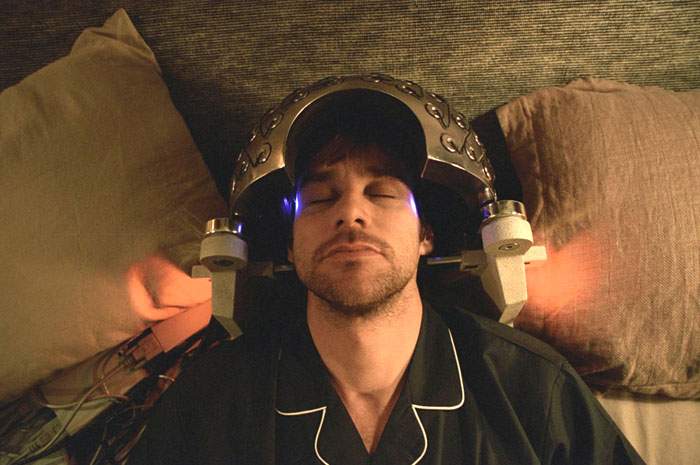In this article, we take a look at the ending of Eternal Sunshine of the Spotless Mind in order to learn what makes it so powerful and effective. What lessons can one learn from this great ending? And how might you incorporate such lessons into your own screenwriting?
Table of Contents
Why a Film’s Ending is So Important
Released in 2004, Eternal Sunshine of the Spotless Mind is written by Charlie Kaufman and directed by Michel Gondry.
- The story tells of the turbulent relationship between Jim Carrey’s ‘Joel’ and Kate Winslet’s ‘Clementine’.
- The film reflects upon the burden of heartbreak, that excruciating process of separating from someone who previously completed you.
Kaufman explores this inevitable human experience through science-fiction. He imagines a world, made possible by Lacuna’s technological ingenuity, in which the pain of a broken heart need not be felt. With the capability of completely erasing an ex-lover from one’s memory, Lacuna claims to provide its customers with the freedom to move on with their lives.
Yet, as the film unfolds, we begin to question the extent to which ignorance can amount to bliss. Ultimately, Eternal Sunshine of the Spotless Mind seeks to discover the value of such pain and why a life of pleasure in toto will not necessarily make us a happier species.
The film’s ending is where these themes are perhaps most present. This means that the ending, maybe more than any other part of the film, leaves us pondering the meaning of the film’s message.
Writing a good ending is often the hardest nut to crack. An ending needs to provide the audience with a sense of closure. Doing so requires some sort of resolution to the plot’s conflict. Yet, achieving this in a satisfying but unforeseeable way can be much harder than it seems.
Endings that appear fabricated can often leave the audience feeling swindled. This is because they have just invested a great deal of emotional energy into the characters on display, only to be reminded of their own gullibility. A bad ending can thus seriously taint the audience’s overall impression of the film.
The Eternal Sunshine Ending; Resolution and Obscurity
What makes Eternal Sunshine of the Spotless Mind’s ending so good is the fine balance Kaufman strikes between resolution and obscurity.
The ending does bring with it a sense of catharsis.
- After both undergoing Lacuna’s procedure, Joel and Clementine somehow manage to fall back into each other’s arms.
- But after Lacuna’s receptionist, Mary Svevo, discovers that Dr. Mierzwiak had used the procedure on her in an effort to cover up the traces of their affair, she decides to send Lacuna’s files back to its clients.
- Consequently, Joel and Clementine are made aware of their complicated history and all the things they once despised about each other.
- Yet, in the face of these harsh truths, the pair choose to give their relationship another chance. Or do they? After all, the characters seem to both resign to their fate but at the same time appear happy to do so.
- Have they agreed to give it another shot or have they agreed to part ways amicably?
Through this, Kaufman establishes the possibility of redemption whilst at the same time maintaining a sense of ambiguity. The audience does not find out what became of Joel and Clementine. Instead, we are left to imagine the rest and bring our own interpretation to it.
Why Does This Make for a Good Ending?
This makes for a good ending since the story itself lives on in the viewer’s mind. Humans have a natural predilection for answers. But in its refusal of any foregone conclusion, that is, by refusing to spell out Joel and Clementine’s fate, the film has a lingering effect.
Its ambiguity allows the audience to make up their own minds, to create their own ending. We may choose to believe that things worked out well or that they just parted ways. We may equally decide the couple stay together but are doomed to repeat the same mistakes.
Regardless, what’s crucial is that the viewer is granted a sense of authorship. By stoking the audience’s imagination, Kaufman forces us to keep the story alive, thus perpetuating the suspension of our disbelief. Ultimately, this amplifies the overall emotional impact of the film.
The Eternal Sunshine Ending’s Philosophical Commentary
Whilst Eternal Sunshine of the Spotless Mind is an emotionally gripping story, it also espouses a wealth of philosophical insight. In fact, much of what makes the film’s ending so good is Kaufman’s final reflections on the nature of love and the way we ought to approach it. Before expanding on this, a discussion of the film’s stance on Lacuna and its overall philosophy is required.
1. Dealing With Heartbreak
Eternal Sunshine of the Spotless Mind is an exploration of the human condition and the way in which we deal with the agony of heartbreak. Kaufman highlights the fact that humans seem to have a natural tendency towards the suppression of negative feelings.
Arguably, love is the most consuming of all human experiences. It follows that heartbreak can be the most excruciating. Upon splitting with someone we care deeply for, after overcoming the initial paralysis, our next step often involves an attempt to eradicate them. We might binge drink to distract ourselves, delete their phone number, or even the photos we have of them.
In essence, humans are susceptible to the notion that moving on from an ex-lover demands forgetting them or at least attempting to.

2. To Forget or Not Forget
Via Lacuna, Kaufman takes this desire to its logical extreme. Dr. Mierzwiak provides his clients with the ability to completely erase troubling memories. The film then problematizes this through Joel and Clementine’s relationship.
- After their split, the impulsive Clementine decides to remove Joel from her memory.
- Discovering this through mutual friends, Joel (perhaps in spite), resolves to do the same.
- As the process of erasure takes place, the audience is shown the inner workings of Joel’s mind. Initially, he’s glad to see her go. “What a perfect ending to this piece of shit story”, he exclaims.
Yet, as Lacuna’s technician delves deeper, Joel begins to reckon with the fact that he’ll lose all the good memories they created too. This culminates in a scene in which Joel and Clementine are lying on a frozen lake. “I could die right now Clem”, he tells her, “I’m just happy, I’ve never felt that before, I’m exactly where I want to be”.
After Clementine fades from this memory too, Joel decides to hide her in some of his deepest and darkest memories in an effort to thwart the process of erasure.

3. Kaufman’s Critique
As David Smith explains, Joel and Clementine seem to want light without its shadow, life without its baggage. In choosing to erase each other, they fail to recognize that experience, that is, happiness and sadness or laughter and anger, is a delicately balanced network.
Through Joel’s realization, Kaufman expresses the fact that life, relationships and love inherently contain both good and bad. To want one and not the other is to yearn for something ‘that is not life’.
Joel and Clementine will never find the peace they are searching for by simply eradicating the painful aspects of their existence.
- As the philosopher Robert Nozick explains in his book Anarchy, State, Utopia, the short-sighted pursuit of pleasure comes at a cost: truth.
- Moreover, philosopher Iris Murdoch similarly points out in her book The Sovereignty of Good that failing to live life upon the authority of truth, or, a refusal to face up to the real situation, will ultimately make for a more dismal existence.
- This is because happiness, in its purest form, derives from truth. Humans have an underlying need to live life truthfully.
Furthermore, by purging themselves of each other, Joel and Clementine also purge the reasons why their relationship broke down in the first place. Consequently, neither is able to grow and learn from their past mistakes.
Thus, after the erasure, when the pair somehow end up on the same beach, their conversation falls into exactly the same pattern as when they first met. Kaufman’s message is clear: without foresight, we would be trapped in an endless cycle of impulse.
4. The Ending’s Denouement
Part of what makes Eternal Sunshine of the Spotless Mind‘s ending so good is the final message that Kaufman leaves us with.
As explained above, upon discovering that her own memory had been erased by Dr. Mierzwiak after their affair, Mary Svevo decides to send Lacuna’s files back to its clients.
As a result, although Joel and Clementine miraculously rekindle their relationship, they quickly become aware of their complicated past and all the things they once despised about each other. The final scene takes place in the corridor of Joel’s apartment:
Joel: Wait.
Clementine: What?
Joel: I don’t know.
Clementine: What do you want Joel?
Joel: I don’t know, I just want you to wait […] for a while.
Clementine: Okay. I’m not a concept Joel, I’m just a fucked up girl looking for my own peace of mind. I’m not perfect.
Joel: I can’t see anything I don’t like about you.
Clementine: But you will, you will think of things, and I’ll get bored with you and feel trapped because that’s what happens with me.
Joel: Okay.
Clementine: Okay.
5. What’s the Final Scene’s Message?
In many ways, this final scene is a summary of Friedrich Nietzsche‘s concept of the eternal recurrence.
- ‘My formula for greatness for a human being’, Nietzsche wrote, ‘is amor fati [love of fate]’.
- He asked, ‘what if this life you now live, you will live […] innumerable times more?’ What if ‘there will be nothing new in it, but every pain and every joy?’ The question is, will you desire it once ‘and innumerable times more?’
- Through this, Nietzsche urges the importance of accepting responsibility for the meaning of our lives by acting in a way that we would want to repeat forever more.
- Consequently, a love of fate entails embracing the inevitability of suffering.
By choosing to give things another go, in spite of the knowledge that they may well be unsuited for each other, Joel and Clementine demonstrate amor fati. They come to realize that suffering is a necessary part of our existence. Without it, we cannot hope for any form of meaningful connection. Desiring this truthful kind of love, Joel and Clementine step into the light aware that a shadow will almost certainly follow.
Clearly, therefore, Eternal Sunshine of the Spotless Mind‘s ending should be applauded for the way it crystallizes the philosophical reflections running throughout the film. More importantly, the ending provides the viewer with an alternative approach to life. It is an approach dictated by truth, courage, and hope.
Joel and Clementine accept the doomed aspects of their bond and either decide to forge on regardless or accept that they cannot be together. This ambiguity is, again, what makes the ending so rewarding. Watching the ending over and over again, one is struck by the sense of fate running through it.
The Film’s Cyclical Structure
Eternal Sunshine of the Spotless Mind’s cyclical structure serves to highlight its philosophical denouement. This is another reason why the film’s ending is so good.
For the sake of clarity, we have previously explained the film in terms of its chronological order. But the film itself does not abide by such chronology. It can be broken into three sections:
- The film begins the morning after Joel has had his memory erased. Whilst on his way to work, he decides to call in sick and take a train to Montauk. It is here that Joel meets Clementine, falling in love with her all over again.
- The film then cuts to the day of their initial split. Joel is devastated and, upon discovering that Clementine had erased him, he decides to do the same to her.
- After a failed attempt to thwart the process of erasure, Joel wakes up and the film’s opening sequence repeats itself. This time, however, it continues after the point from which it was initially cut. Mary Svevo’s actions are revealed and so too is the fact that Joel and Clementine had previously dated.
Why Does This Cyclical Structure Work?
Eternal Sunshine of the Spotless Mind’s cyclical structure reinforces the film’s overall message. In a way, it imposes Joel and Clementine’s blissful ignorance on the audience itself. We experience the opening sequence exactly as they do as well as section three’s revelation.
Before learning of her affair with Dr. Mierzwiak, Mary Svevo was in awe of him. In defending the ‘good’ work that Lacuna does, Svevo says: “you look at a baby and it’s so fresh, so clean. Adults, they’re like this mess of anger and phobias and sadness and hopelessness. And Howard just makes it go away”.
Kaufman is clearly at odds with this. The film’s overall message is that you cannot walk through life blind. You need to be aware of the full facts, and the full range of experience. How can you act in a way that you would want to repeat forever with only partial insight?
The film’s cyclical structure ultimately amplifies this message by forcing the audience to experience the narrative as its protagonists do.
The Film’s Ambiguous Ending
The ambiguity of the film’s ending further reinforces Kaufman’s message. In the final shot of the film, we see Joel and Clementine, now a seemingly happy couple, playing around on a snowy beach. The shot then fades to white.


Kaufman and Gondry are purposefully ambiguous here. Earlier, we discussed how the ending’s balance of resolution and obscurity makes the film more emotionally impactful. This is due to the way in which it forces the audience to continue investing in Joel and Clementine’s relationship after the film has finished.
The ambiguity of this final shot raises a question: did Joel and Clementine live happily ever after, or were they doomed to repeat the same mistakes? Gondry insinuates the latter by looping this final shot three times before it fades to white. Is this the last memory to be erased? Is the memory gradually fading?
Its uncertainty ultimately underlines the approach to life that Kaufman advocates. Like Nietzsche, he likens human experience to both sides of the same coin – neither can exist separately. Thus, to want love is to welcome suffering. The ending’s duality highlights this, forcing the audience to consider and accept both possibilities.
The Simplicity of “Okay”
The previous two sections have explored the way form is used by Kaufman and Gondry to guide the viewer’s digestion of the ideas which the film explores. Yet, part of what makes the Eternal Sunshine ending so good is the space provided for the audience to make their own assessment.
The great depth of emotional and intellectual meaning the ending provides is contained within the simple “okay” uttered by Joel and Clementine.
This contains all we need to know. By saying “okay”, the pair say yes with open eyes to the whole foreseeable mess that potentially awaits them. The moment feels like liberation, like the change they’d been searching for all along.
A Lasting Impression
Often, in attempting to leave a lasting impression and make sure their message is understood, the inexperienced writer will overfill their screenplay’s ending. This will, however, undermine the intended effect.
A good ending, instead, needs to provide room for the audience to think. Yes, it must contain answers, but the viewer needs to find such answers for themselves. In doing so, the film will, in the end, prove that much more rewarding. This is what makes a truly great ending. The story, in a sense, doesn’t end with the cut to a black screen. Instead, it sits within the audience’s mind, carrying on the story in some way.
Ultimately, this is why the Eternal Sunshine of the Spotless Mind ending is so good. It is an intellectually challenging film, but it doesn’t have to be. It can be viewed and enjoyed both within and beyond the sum of its parts. Accordingly, whilst Kaufman’s ending does provide a rich philosophical approach to love, it has a hidden quality: you must search it out.
– Enjoyed our analysis of The Eternal Sunshine of the Spotless Mind ending? Check out our analysis of why the Citizen Kane ending is so good.
– What did you think of this article? Share It, Like It, give it a rating, and let us know your thoughts in the comments box further down…
– Struggling with a script or book? Story analysis is what we do, all day, every day… check out our range of script coverage services for writers & filmmakers.
This article was written by Theo Collins and edited by IS Staff.
Get *ALL* our FREE Resources
Tackle the trickiest areas of screenwriting with our exclusive eBooks. Get all our FREE resources when you join 60,000 filmmakers on our mailing list!

